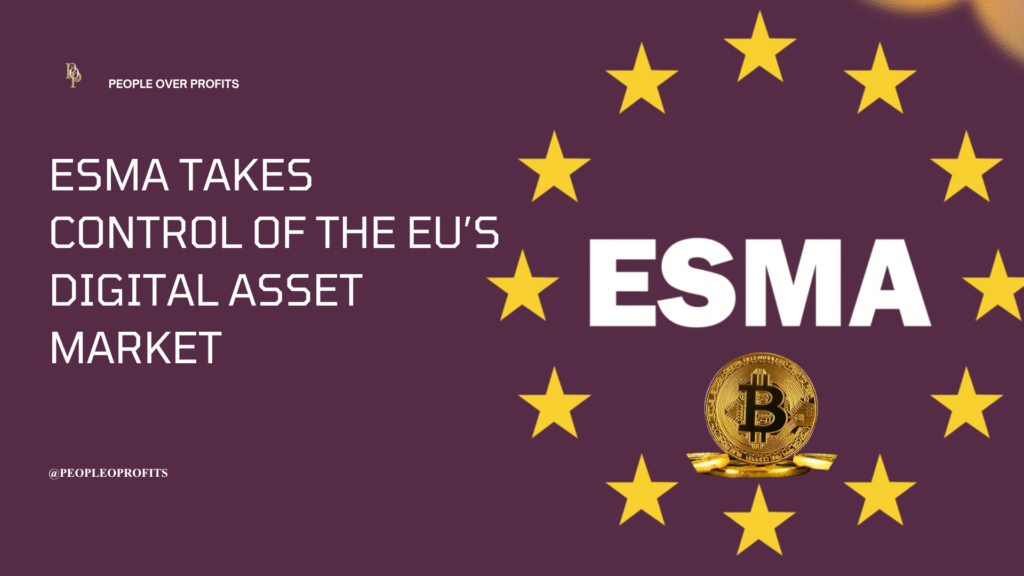Key Takeaways
- The European Securities and Markets Authority (ESMA) is set to take direct control over crypto oversight across the European Union.
- This move aims to unify fragmented national regulations under a single, EU-wide framework.
- Experts say this could either boost investor protection and innovation or stifle competition through centralized control.
In a landmark move, the European Securities and Markets Authority (ESMA) is set to centralize crypto oversight across all member states, reshaping how digital assets are governed in Europe. This isn’t just a bureaucratic shift, it’s a power move aimed at unifying Europe’s fragmented crypto landscape. The big question now is whether this bold centralization will ignite innovation or choke it under regulation.
The Push for Unified Oversight
The European Union is tightening its grip on the crypto market. In a bold regulatory shift, the European Securities and Markets Authority (ESMA) will assume centralized authority over crypto exchanges, stablecoin issuers, and digital asset custodians across the EU.
For years, European nations operated under fragmented national laws: Germany had BaFin, France had AMF, Spain had CNMV. But now, Brussels wants one voice, one standard, and one enforcement body for all crypto operations.
At its core, this is about consistency and credibility. ESMA wants to prevent “regulatory arbitrage” where crypto companies shop around for lenient jurisdictions to set up operations. The aim is clear: create a single, trusted digital market that aligns with MiCAR’s (Markets in Crypto-Assets Regulation) spirit of transparency and consumer protection.
What This Means for Crypto Businesses
Under ESMA’s new structure, all crypto exchanges, wallet providers, and token issuers will have to register directly with the agency. No more hiding under local loopholes.
While this creates a more predictable regulatory environment, it also raises the cost of compliance. Startups could struggle with stricter reporting requirements, risk assessments, and capital obligations. On the other hand, institutions and mainstream investors may finally see crypto as a safer, more regulated space to enter.
Why This Move Matters
Europe is positioning itself as the global leader in responsible crypto regulation. The U.S. is still caught in legal gridlock between the SEC and CFTC, while Asia remains split between pro-innovation hubs and tight state control.
By consolidating oversight, Europe is sending a clear message: we’re not banning crypto, we’re organizing it.
This balance between innovation and protection could set the tone for global standards, much like GDPR did for data privacy. If ESMA succeeds, the EU could become the world’s benchmark for transparent, compliant crypto ecosystems.
The Power Shift Within Europe
Critics argue that this move concentrates too much power in Brussels. Smaller regulators fear being sidelined, while companies worry about slower approvals due to bureaucratic centralization.
Still, ESMA’s supporters see it as a necessary evolution. In a borderless market like crypto, fragmented oversight equals weak oversight. A single authority could reduce fraud, enhance investor trust, and create a level playing field for innovators.
What Experts Say
- Financial Analysts believe ESMA’s direct control will give the EU a competitive edge by building regulatory trust that attracts global investors.
- Crypto Lawyers warn that startups might face higher barriers to entry, potentially pushing innovation outside Europe.
- Blockchain Developers are cautiously optimistic, noting that clear rules are better than unpredictable enforcement but urge ESMA to involve the tech community in policy decisions.
What Could Go Right or Wrong?
- Bull Case: ESMA successfully harmonizes crypto rules across the EU, making Europe a safe and attractive hub for digital asset innovation. Institutional investment flows in, and EU-based stablecoins thrive under clear regulation.
- Bear Case: Heavy-handed oversight drives smaller projects and DeFi innovators to relocate to regions with looser policies, like Dubai or Singapore. Europe gains safety, but loses its creative edge.
- Base Case The transition brings initial friction but stabilizes over time. ESMA’s oversight creates regulatory clarity, attracting major players while smaller startups adapt or merge to survive.
Final Thoughts
Europe’s decision to hand crypto regulation to ESMA marks a defining moment for digital finance. It’s not just a bureaucratic change, it’s a strategic repositioning of how crypto fits into global economics. If successful, ESMA could set a precedent for trust-based blockchain innovation, proving that regulation and progress can coexist. But if mishandled, it might just reinforce crypto’s long-standing skepticism toward centralized authority.
The question now is: Will Europe’s centralized approach become the blueprint for global crypto oversight or the reason innovation shifts elsewhere? Let us know your thoughts in the comment section.
Follow People Over Profits for more insights on how global regulation, blockchain, and Web3 innovation are reshaping the future of finance.

